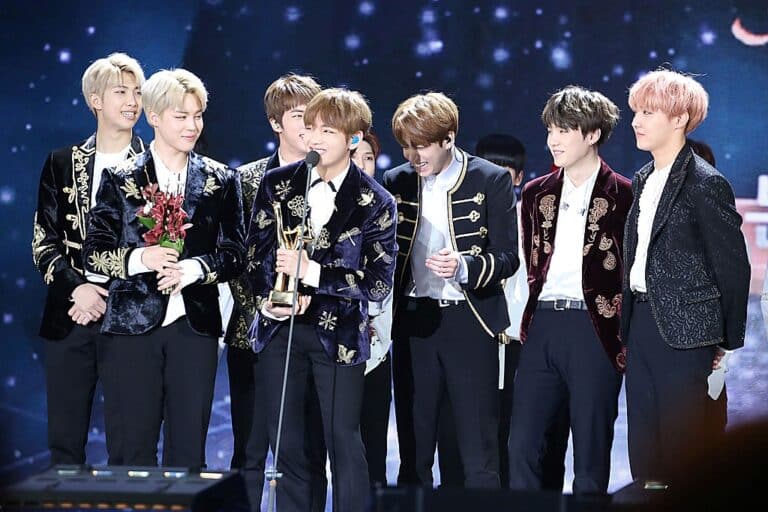BTS accepts a Bonsang award at the 31st Golden Disk Awards in Seoul, 2017 (CC AJEONG_JM)
K-pop is everywhere. Whether it’s at Qatar’s World Cup opening ceremony, where Jung Kook of Korean band BTS performed, or inTwitter threads, where there’s usually at least one “fancam” focused on a star from the genre. K-pop idols are featured across the entire cultural landscape. And the hype is accidental.
Music groups that sing catchy melodies with impeccable pitch and perfectly in-sync dance moves showcasing professional choreographies. On stage, K-pop group members appear anything but human. And that “K” is not just an adjective for the word “pop”, like “latino” would be when talking about music made in Latin America. While this latter genre refers to a variant of conventional pop, the former goes far and beyond, transforming the meaning of the word completely.

It’s no longer a reference to a music genre, but a cultural product that transcends catchy tunes: it’s the star piece of the so-called “Hallyu” or Korean Wave, which has led the country to dominate the global scene. Film, television, cosmetics, music, and literature…. From Parasite’s four Oscars, to Squid Game’s 14 Emmy nominations and the unquestionable growth of the Korean beauty industry. South Korea has claimed a seat at the table among those who decide what the world is and what it looks like, inspiring people to learn their language, adopt their aesthetics and even practice their customs. K-pop is at the heart of all this.
As former South Korean president Park Geun-Hye said, “in the 21st century, culture is power.” K-pop alone generates approximately 10 billion dollars for the country’s economy annually. Its stars have crossed over the limits of the culture world and have reached the most important geopolitical stages. Boy band BTS participated in the most watched White House press conference in the history of the United States, which at least 200,000 people connected live for, to discuss hate crimes committed against the Asian population. The band has also delivered two speeches before the UN General Assembly, to talk about their vision of how young people can achieve a better world.
South Korea has claimed a seat at the table among those who decide what’ the world is and what it looks like
However, it would be a mistake to think of the K-pop phenomenon and its success as a result of a political strategy. It is, above all, an industry. As Stella Soonsung Lee, who has worked at different record labels in the genre, including YG and SM Entertainment, explained to Aceprensa, “The record companies are very much independent, and the government is not very involved. Even so, there are government organizations related to culture that organize international events, and the achievements of artists are recognized and emphasized by politicians.”
A cultural phenomenon, a capitalist macrostructure
Before the 90s there was no “K-pop,” but rather, Korean popular music. Well-known, popular and familiar. Young people listened to the same tunes that their parents liked, and their parents’ parents. Until the band Seo Taiji added the “K” to the term in 1992 in a national television contest. While they scored very poorly on the show, they inspired young people to pursue “different music,” as music critic Kim Bong Hyon notes in the documentary “The Evolution of K-Pop.” Their song, once it was released, stayed at number 1 for 17 weeks on the South Korean charts. They were the first big Korean band, adapting different musical genres such as rock, pop, ballads, hip hop and rap, to transform the notion of popular music in the country. Their albums touched on new subjects that appealed more to the younger generations.
It wasn’t long before record companies recognized the success of Seo Taiji’s formula and wanted to replicate it. Just like that: replicate it. And improve it. Four years after Seo Taiji’s debut, the agency SM Entertainment began looking for boys who could be the next K-pop stars. And that’s how they recruited the members of H.O.T. Kangta. One of them shares in the documentary that he was discovered walking through a shopping mall in Seoul, whereby he was handed a business card and told to get in touch.
In the creative process, these agencies are the ones with a say and who ultimately decide what K-pop is
Ultimately, the agency formed the band and taught them how to sing, dance and amaze the audience. All they had to bring was their good looks and attitude. By the time they debuted, their material was already near perfect, excellently coordinated, with choreographies that blended perfectly with the music, and flawless synchronization. SM didn’t create K-pop stars, like the Seo Taiji members had been —SM created idols.
Out of a factory, towards an altar
And SM wasn’t the only record company to do this. The formula caught on quickly throughout the Korean music industry. To this day, studios choose boys and girls between the ages of 10 and 12, through auditions, to go to special schools, where they’re taught to dance, sing and, basically, be famous. They spend most of their days rehearsing, and when enough time has passed, some of them are chosen to make their idol debut, either as a member of a group, or as a star on their own.
And this brings us back to the fact that K-pop it is not a music genre, but an industry. Soonsung Lee stresses that it would be a mistake to focus on the performers alone when analyzing this phenomenon: “In addition to the artists themselves, the joint efforts of the agency employees, stylists, producers and music engineers, as well as dancers, is huge. There are many professionals working day and night for an artist or a group to make it in the industry”.
Typically, the young stars-to-be sign contracts as soon as they begin their grooming, long-term contracts that specify that their record labels can control what they eat, how they act in public, and even their romantic lives. In addition, the contracts specify what type of music they’ll record and the accompanying choreographies, according to what labels believe will sell the most, as several people now-retired from the industry explained in an interview with youtuber Antony Padilla. In the creative process, these agencies are the ones with a say and who ultimately decide what K-pop is.
They carefully follow what other successful bands have already done, blurring the individualities of artists and groups, until what remains of them is a sort of nebulous entity which can fall under the “K-pop” label. Women are often presented as “good girls” or “femme fatales,” and men are frequently cast as either “bad boys” or the “sophisticated man.”
This is how K-pop as we know it was born, an industry that creates talent, then exports it and sells it, along with the country’s brand. Training camps where talent is grown and content – a lot of content – is produced. H.O.T. Kangta proved that this formula was the ticket to conquering international stages with his performance with Michael Jackson in 1999. In 2012, PSY made history with Gangam style. And now, BlackPink is headlining Coachella, the world’s biggest music festival, NCT 127’s dances can be found in any Twitter thread, and BTS has conquered the Billboard charts.
“While K-pop stars often struggle with physical limitations, or even mental distress because they are human beings, virtual artists can be free from these” —Park Jieun, creator of Eternity
As it has become more accessible to the West, K-pop has had to change, in a sense. Lyrics in English are increasingly common (both BTS, BlackPink and Twice, the best-known bands of today, have some songs entirely in English). And while the training camps and contracts are still up and running, the record labels have made it a priority to overhaul them, limiting their reach, and making them less intrusive. It’s a response to protect their stars, several of which have taken their own lives at the height of their careers, like the most-recent death of Moonbin, a member of the band Astro, who passed away on April 19.
Fans as armies
The romantic lives of the stars, however, are still closely monitored… as they are, ultimately, expected to be most “involved” with their fans. Always available, always for them. The illusion of perfection that so often accompanies idols is also preserved… Until now, no one has seen a pore on their faces or a hair out of place. The less human they appear, the better. In the K-Pop world, the humanity of the artists is a backdrop, as is their creativity and personal expression. So much so that in 2021 the girl band Eternity was born, whose members are 11 hyperreal avatars created with artificial intelligence. Their debut song “I’m real” got millions of views on the internet. Park Jieun, who’s behind the band, told the BBC that she’s convinced this is where the future of K-pop lies: “The advantage of having virtual artists is that, while K-pop stars often struggle with physical limitations, or even mental distress because they are human beings, virtual artists can be free from these.”
There’s a reason for this inhuman aspiration towards perfection. The backbone of this world are the fans, who are willing to change their appearance to look like their idols, learn Korean and even interfere in foreign policy issues, flooding Donald Trump’s Twitter comment section or white supremacist chatrooms with “fancams”. BTS fans, for example, call themselves “army”. According to their official page, the meaning behind the nickname has to do with the unity that exists between the fans and the group, who are always together like a military unit.
But it’s not just the apparent perfection of their idols that makes fans so loyal; it’s also the amount of content the industry produces surrounding them and how they foster parasocial relationships. 22-year-old Colombian Sofía Velásquez told Aceprensa that she started to like K-pop partly because she saw that, unlike Western artists and bands, it allowed her to feel close to the stars. “Before, I used to be a One Direction fan, but there were only about five interviews of them to watch: three videos that the actual band had produced, and some fan-made. But, with K-pop, there is a lot of content from each band, from each star… videos of them eating, talking, in a park, in their day to day lives.” No cultural industry, it could be said, inspires the same level of fandom as K-pop, which includes a sector of marginalized fans known as “sasaeng fans,” or obsessive supporters dedicated to stalking, harassing and following the stars in their private lives.
No, K-pop is not just another music genre. Nor is it a mere element of the Korean Wave or South Korea’s soft power strategy. K-pop is an entire world, in which stars are produced and sold through spectacular dances and catchy rhythms, who inspire in fans, more than any other celebrity. The unattainable ideal of perfection in an artist, capable of moving people and deserving, why not, a seat at the White House and the United Nations.
Translated from Spanish by Lucia K. Maher
